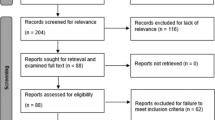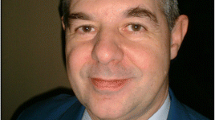Abstract
Hypothesis
Body surface topography (ST) improvements are associated with surgical correction in adolescent idiopathic scoliosis (AIS) and correlate with radiographic imaging.
Design
Prospective observational study.
Introduction
Patients undergoing correction of AIS are most affected by body image. Radiographs have been the standard assessment tool but do not assess body shape features. ST, a validated, radiation-free assessment tool, directly represents the patient’s deformity. We set out to assess ST improvements associated with surgical correction in AIS.
Methods
Twenty-three consecutive operative AIS patients were enrolled and had radiographs and posterior ST obtained pre- and postoperatively (PO). ST changes were compared using paired t test, and correlations of ST with radiograph measurements were evaluated by linear regression.
Results
Mean age at surgery was 15.0 ± 2 years, 82.6% female with mean follow-up of 1.0 year. Major Cobb angle improved from 56.91° ± 15.57° to 13.70° ± 4.89°. ST scoliosis angle corrected from 41.43° ± 11.52° to 11.78° ± 7.84° (p < .0001). Trunk length increased from 401.22 ± 32.43 to 422.30 ± 25.77 mm (Δ21.08 mm; p = .0004). Pelvic obliquity (waist asymmetry) trended toward improvement (6.0 ± 4.3 vs. 5.3 ± 7.1 mm; p = .06). Surface rotation was corrected from 17.35 ± 6.73 to 11.8 ± 4.12 mm (p < .0001), highly correlated with clinical trunk rotation (T p = .002 and TL p = .02). ST highly correlated with radiographic parameters. Sagittal balance correlated with improved function (p = .02).
Conclusion
ST, a radiation-free body shape assessment tool, improved with surgical correction of AIS and was highly correlated with radiographic outcomes.



Similar content being viewed by others
References
SRS e-text book. https://etext.srs.org/book/. Accessed 19 June 2017
Wajchenberg M, Astur N, Kanas M, Martins DE (2016) Adolescent idiopathic scoliosis: current concepts on neurological and muscular etiologies. Scoliosis Spinal Disord 11:4
Asher M, Min Lai S, Burton D, Manna B (2003) The reliability and concurrent validity of the scoliosis research society-22 patient questionnaire for idiopathic scoliosis. Spine (Phila Pa 1976) 28:63–69
Carreon LY, Sanders JO, Diab M, Spinal Deformity Study Group et al (2010) The minimum clinically important difference in Scoliosis Research Society-22 22 appearance, activity, and pain domains after surgical correction of adolescent idiopathic scoliosis. Spine (Phila Pa 1976) 35:2079–2083
Haher TR, Gorup JM, Shin TM et al (1999) Results of the Scoliosis Research Society instrument for evaluation of surgical outcome in adolescent idiopathic scoliosis. A multicenter study of 244 patients. Spine 24:1435–1440
Verma K, Lonner B, Toombs CS et al (2014) International utilization of the SRS-22 instrument to assess outcomes in adolescent idiopathic scoliosis: what can we learn from a medical outreach group in Ghana? J Pediatr Orthop 34:503–508
Auerbach JD, Lonner BS, Crerand CE et al (2014) Body image in patients with adolescent idiopathic scoliosis: validation of the body image disturbance questionnaire-scoliosis version. J Bone Jt Surg Am 96:e61
Bao H, Yan P, Lonner B et al (2015) Validation of the simplified Chinese version of the Body Image Disturbance Questionnaire-Scoliosis. Spine (Phila Pa 1976) 40:E1155–E1160
Lonner BS, Auerbach JD, Estreicher MB et al (2009) Video-assisted thoracoscopic spinal fusion compared to posterior spinal fusion with thoracic pedicle screws for thoracic adolescent idiopathic scoliosis. J Bone Jt Surg 91:398–408
Lonner BS, Yoo A, Terran JS et al (2013) Effect of spinal deformity on adolescent quality of life: comparison of operative Scheuermann’s kyphosis, adolescent idiopathic scoliosis and normal controls. Spine 38:1049–1055
Sanders JO, Harrast JJ, Kuklo TR, Spinal Deformity Study Group et al (2007) The Spinal Appearance Questionnaire: results of reliability, validity, and responsiveness testing in patients with idiopathic scoliosis. Spine (Phila Pa 1976) 32:2719–2722
Lonner B, Parent S, Shah SA et al (2015) How surgery impacts the view in the mirror for the AIS patient—TAASQ Questionnaire Responsiveness to Change. Paper 556. Paper presented at: American Academy of Orthopaedic Surgeons annual meeting; March 24–28, 2015; Las Vegas, NV
Lonner B, Toombs C, Shah S et al (2014) What an AIS patient sees in the mirror: validation of the Truncal Anterior Asymmetry Scoliosis Questionnaire (TAASQ). Poster P372. AAOS annual meeting, March 11–15, 2014. New Orleans, Louisiana
Takasaki H (1970) Moiré topography. Appl Opt 9:1467–1472
Willner S (1979) Moiré topography—a method for school screening of scoliosis. Arch Orthop Trauma Surg 95:181–185
Yamamoto S, Shigematsu H, Kadono F et al (2015) Adolescent scoliosis screening in Nara city schools: a 23-year retrospective cross-sectional study. Asian Spine J 9:407–415
Adair IV, Van Wijk MC, Armstrong GW (1977) Moiré topography in scoliosis screening. Clin Orthop Relat Res 129:165–171
Ramsay J, Seoud L, Barchi S et al (2017) Assessment of breast asymmetry in adolescent idiopathic scoliosis using an automated 3D body surface measurement technique. Spine Deform 5:152–158
DIERS Medical Systems. https://www.diersmedical.com. Accessed 27 June 2017
Turner-Smith AR, Harris JD, Houghton GR, Jefferson RJ (1988) A method for analysis of back shape in scoliosis. J Biomech 21:497–509
Zubović A, Davies N, Berryman F et al (2008) New method of scoliosis deformity assessment: ISIS2 system. Stud Health Technol Inform 140:157–160
Macdonald AM, Griffiths CJ, MacArdle FJ, Gibson MJ (2002) The effect of posture on Quantec measurements. Stud Health Technol Inform 91:190e3
Hill DL, Berg DC, Raso VJ et al (2002) Evaluation of a laser scanner for surface topography. Stud Health Technol Inform 88:90–94
Knott P, Sturm P, Lonner B et al (2016) Multicenter comparison of 3D spinal measurements using surface topography with those from conventional radiography. Spine Deform 4:98–103
Komeili A, Westover L, Parent EC et al (2015) Correlation between a novel surface topography asymmetry analysis and radiographic data in scoliosis. Spine Deform 3:303–311
Pazos V, Cheriet F, Song L et al (2005) Accuracy assessment of human trunk surface 3D reconstructions from an optical digitising system. Med Biol Eng Comput 43:11–15
Frerich JM, Hertzler K, Knott P, Mardjetko S (2012) Comparison of radiographic and surface topography measurements in adolescents with idiopathic scoliosis. Open Orthop J 6:261–265
Newton PO, Khandwala Y, Bartley CE et al (2016) New EOS imaging protocol allows a substantial reduction in radiation exposure for scoliosis patients. Spine Deform 4:138–144
Danielsson AJ, Nachemson AL (2003) Back pain and function 23 years after fusion for adolescent idiopathic scoliosis: a case-control study—part II. Spine (Phila Pa 1976) 28:E373–E383
Danielsson AJ, Nachemson AL (2003) Back pain and function 22 years after brace treatment for adolescent idiopathic scoliosis: a case-control study—part I. Spine (Phila Pa 1976) 28:2078–2085
Larson AN, Fletcher ND, Daniel C, Richards BS (2012) Lumbar curve is stable after selective thoracic fusion for adolescent idiopathic scoliosis: a 20-year follow-up. Spine (Phila Pa 1976) 37:833–839
Weinstein SL (1986) Idiopathic scoliosis. Natural history. Spine (Phila Pa 1976) 11:780–783
Weinstein SL, Dolan LA, Spratt KF et al (2003) Health and function of patients with untreated idiopathic scoliosis: a 50-year natural history study. JAMA 289:559–567
Asher MA, Burton DC (2006) Adolescent idiopathic scoliosis: natural history and long term treatment effects. Scoliosis 1:2
Lonner BS, Ren Y, Bess S et al (2016) Surgery for the adolescent idiopathic scoliosis patients after skeletal maturity: now or later? Hibbs Clinical Award Nominee for Best Clinical Paper. Paper 38. Paper presented at: Scoliosis Research Society (SRS) 51st annual meeting & Course; September 21–24, 2016; Prague, Czech Republic
Lonner BS, Toombs C, Shah SA et al (2013) Quality of life improvement following surgery for Scheuermann’s kyphosis compared to adolescent idiopathic scoliosis. Paper 99. Paper presented at: 48th annual meeting & course; September 18–21, 2013; Lyon, France
Lonner BS, Ren Y, Yaszay B et al (2016) Evolution of surgery for adolescent idiopathic scoliosis over 20 years: have outcomes improved? Paper 48. Paper presented at: Scoliosis Research Society (SRS) 51st annual meeting & course; September 21–24, 2016; Prague, Czech Republic
Haher TR, Gorup JM, Shin TM et al (1999) Results of the Scoliosis Research Society instrument for evaluation of surgical outcome in adolescent idiopathic scoliosis: a multi-center study of 244 patients. Spine 24:1435–1440
Flynn JM, Betz RR, O’Brien MF, Newton PO, The Harms Study Group (2010) Radiographic classification of complications of instrumentation in adolescent idiopathic scoliosis. Clin Orthop Relat Res 468:665–669
Funding
No research funding was received.
Author information
Authors and Affiliations
Corresponding author
Ethics declarations
Conflict of interest
BSL (Grants from Setting Scoliosis Straight Foundation; personal fees from DePuy Synthes Spine, K2M, Paradigm Spine, Spine Search, and Ethicon; nonfinancial support from Spine Deformity journal; grants from John and Marcella Fox Fund Grant and Orthopaedic Research and Education Foundation; personal fees from Zimmer Biomet, Apifix, and Unyq, outside the submitted work), AC (none), GK (none), YR (none).
IRB approval
This study was reviewed and approved by Mount Sinai Hospital Institutional Review Board.
Additional information
Publisher's Note
Springer Nature remains neutral with regard to jurisdictional claims in published maps and institutional affiliations.
Rights and permissions
About this article
Cite this article
Lonner, B.S., Castillo, A., Kassin, G. et al. Surface topography assessment of body shape after surgical correction in adolescent idiopathic scoliosis. Spine Deform 8, 213–220 (2020). https://doi.org/10.1007/s43390-020-00041-4
Received:
Accepted:
Published:
Issue Date:
DOI: https://doi.org/10.1007/s43390-020-00041-4




